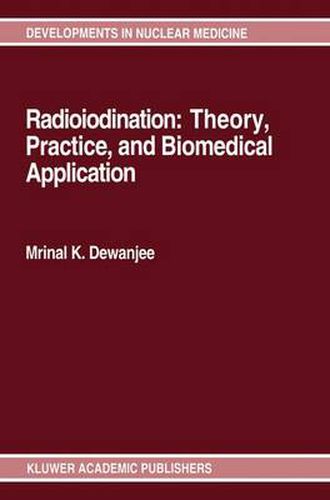Readings Newsletter
Become a Readings Member to make your shopping experience even easier.
Sign in or sign up for free!
You’re not far away from qualifying for FREE standard shipping within Australia
You’ve qualified for FREE standard shipping within Australia
The cart is loading…






This title is printed to order. This book may have been self-published. If so, we cannot guarantee the quality of the content. In the main most books will have gone through the editing process however some may not. We therefore suggest that you be aware of this before ordering this book. If in doubt check either the author or publisher’s details as we are unable to accept any returns unless they are faulty. Please contact us if you have any questions.
Among the readily available -emitting radionuclides, the nuclides of iodine have the greatest versatility in labeling both the hydrophilic and the lipophilic compounds that are used in biology and medicine. Biologically important micrmolecules, semimacromolecules, and macromolecules have been identified which, after iodination, almost maintain the same molecular configuration and similar biologic specificity as those of the parent molecules. The multiple techniques for iodination and the clinical use of iodinated products have made possible the present status of the development of diagnostic nuclear medicine. 125r, with a half-life of 60 days, has a crucial role in competitive protein-binding studies. 131r is useful for measuring thyroid uptake, for the diagnosis of thyroid carcinoma and metastasis, and for therapy. 1nr , with a reasonably shorter half-life, is almost ideal for thyroid workup and for a few useful labeled radiopharmaceutical. Although ~c is used more widely in diagnostic procedures, the radionuclides of iodine will always have a major role in biology and medicine. A considerable amount of information is scattered in the literature regarding the chemistry of radioiodination and the mechanism of tracer localization in cells and tissues. Labeled peptides, proteins, and antibodies are extensively used for protein turnover studies, receptor binding and tumor imaging studies, and radioimmunoassay. The general trend in the use of tracers in clinical nuclear medicine has been an evolution from 3H, 14C, 11C, and 13 to 125 , 131 and 123r to ~c and 111rn.
$9.00 standard shipping within Australia
FREE standard shipping within Australia for orders over $100.00
Express & International shipping calculated at checkout
This title is printed to order. This book may have been self-published. If so, we cannot guarantee the quality of the content. In the main most books will have gone through the editing process however some may not. We therefore suggest that you be aware of this before ordering this book. If in doubt check either the author or publisher’s details as we are unable to accept any returns unless they are faulty. Please contact us if you have any questions.
Among the readily available -emitting radionuclides, the nuclides of iodine have the greatest versatility in labeling both the hydrophilic and the lipophilic compounds that are used in biology and medicine. Biologically important micrmolecules, semimacromolecules, and macromolecules have been identified which, after iodination, almost maintain the same molecular configuration and similar biologic specificity as those of the parent molecules. The multiple techniques for iodination and the clinical use of iodinated products have made possible the present status of the development of diagnostic nuclear medicine. 125r, with a half-life of 60 days, has a crucial role in competitive protein-binding studies. 131r is useful for measuring thyroid uptake, for the diagnosis of thyroid carcinoma and metastasis, and for therapy. 1nr , with a reasonably shorter half-life, is almost ideal for thyroid workup and for a few useful labeled radiopharmaceutical. Although ~c is used more widely in diagnostic procedures, the radionuclides of iodine will always have a major role in biology and medicine. A considerable amount of information is scattered in the literature regarding the chemistry of radioiodination and the mechanism of tracer localization in cells and tissues. Labeled peptides, proteins, and antibodies are extensively used for protein turnover studies, receptor binding and tumor imaging studies, and radioimmunoassay. The general trend in the use of tracers in clinical nuclear medicine has been an evolution from 3H, 14C, 11C, and 13 to 125 , 131 and 123r to ~c and 111rn.